Improving Mechanical, Thermal and Damping Properties of NiTi (Nitinol) Reinforced Aluminum Nanocomposites
Abstract
1. Introduction
2. Experimental Procedure
2.1. Materials Processing
2.2. Materials Characterization
3. Results and Discussion
3.1. Microstructural Characterization
3.2. Mechanical Properties
Possible Strengthening Mechanisms
3.3. Fracture Behavior
3.4. Coefficient of Thermal Expansion
3.5. Damping Behavior
4. Conclusions
Author Contributions
Funding
Conflicts of Interest
References
- Reddy, M.P.; Manakari, V.; Parande, G.; Shakoor, R.; Srivatsan, T.; Gupta, M. The Mechanical and Thermal Response of Shape Memory Alloy-Reinforced Aluminum Nanocomposites. In Nanocomposites VI: Nanoscience and Nanotechnology in Advanced Composites; Springer: Berlin/Heidelberg, Germany, 2019; pp. 51–62. [Google Scholar]
- Jayalakshmi, S.; Gupta, S.; Sankaranarayanan, S.; Sahu, S.; Gupta, M. Structural and mechanical properties of Ni60Nb40 amorphous alloy particle reinforced Al-based composites produced by microwave-assisted rapid sintering. Mater. Sci. Eng. A 2013, 581, 119–127. [Google Scholar] [CrossRef]
- Koli, D.K.; Agnihotri, G.; Purohit, R. Advanced aluminium matrix composites: The critical need of automotive and aerospace engineering fields. Mater. Today Proc. 2015, 2, 3032–3041. [Google Scholar] [CrossRef]
- Matli, P.R.; Ubaid, F.; Shakoor, R.A.; Parande, G.; Manakari, V.; Yusuf, M.; Mohamed, A.M.A.; Gupta, M. Improved properties of Al–Si 3 N 4 nanocomposites fabricated through a microwave sintering and hot extrusion process. RSC Adv. 2017, 7, 34401–34410. [Google Scholar] [CrossRef]
- Miracle, D. Metal matrix composites–from science to technological significance. Compos. Sci. Technol. 2005, 65, 2526–2540. [Google Scholar] [CrossRef]
- Torralba, J.D.; Da Costa, C.; Velasco, F. P/M aluminum matrix composites: An overview. J. Mater. Process. Technol. 2003, 133, 203–206. [Google Scholar] [CrossRef]
- Zhang, Y.; Ma, N.; Wang, H.; Le, Y.; Li, X. Damping capacity of in situ TiB2 particulates reinforced aluminium composites with Ti addition. Mater. Des. 2007, 28, 628–632. [Google Scholar] [CrossRef]
- Reddy, M.P.; Manakari, V.; Parande, G.; Shakoor, R.A.; Mohamed, A.M.A.; Gupta, M. Structural, mechanical and thermal characteristics of Al-Cu-Li particle reinforced Al-matrix composites synthesized by microwave sintering and hot extrusion. Compos. Part B Eng. 2019, 164, 485–492. [Google Scholar] [CrossRef]
- Reddy, M.P.; Himyan, M.; Ubaid, F.; Shakoor, R.; Vyasaraj, M.; Gururaj, P.; Yusuf, M.; Mohamed, A.; Gupta, M. Enhancing thermal and mechanical response of aluminum using nanolength scale TiC ceramic reinforcement. Ceram. Int. 2018, 44, 9247–9254. [Google Scholar] [CrossRef]
- Reddy, M.P.; Manakari, V.; Parande, G.; Ubaid, F.; Shakoor, R.; Mohamed, A.; Gupta, M. Enhancing compressive, tensile, thermal and damping response of pure Al using BN nanoparticles. J. Alloys Compd. 2018, 762, 398–408. [Google Scholar] [CrossRef]
- Reddy, M.P.; Shakoor, R.; Parande, G.; Manakari, V.; Ubaid, F.; Mohamed, A.; Gupta, M. Enhanced performance of nano-sized SiC reinforced Al metal matrix nanocomposites synthesized through microwave sintering and hot extrusion techniques. Prog. Nat. Sci. Mater. Int. 2017, 27, 606–614. [Google Scholar] [CrossRef]
- Reddy, M.P.; Ubaid, F.; Shakoor, R.; Parande, G.; Manakari, V.; Mohamed, A.; Gupta, M. Effect of reinforcement concentration on the properties of hot extruded Al-Al2O3 composites synthesized through microwave sintering process. Mater. Sci. Eng. A 2017, 696, 60–69. [Google Scholar] [CrossRef]
- Moazami-Goudarzi, M.; Akhlaghi, F. Wear behavior of Al 5252 alloy reinforced with micrometric and nanometric SiC particles. Tribol. Int. 2016, 102, 28–37. [Google Scholar] [CrossRef]
- Soltani, N.; Sadrnezhaad, S.; Bahrami, A. Manufacturing wear-resistant 10Ce-TZP/Al2O3 nanoparticle aluminum composite by powder metallurgy processing. Mater. Manuf. Process. 2014, 29, 1237–1244. [Google Scholar] [CrossRef]
- Byrne, C.J.; Eldrup, M. Bulk metallic glasses. Science 2008, 321, 502–503. [Google Scholar] [CrossRef]
- Manakari, V.; Parande, G.; Doddamani, M.; Gupta, M. Evaluation of wear resistance of magnesium/glass microballoon syntactic foams for engineering/biomedical applications. Ceram. Int. 2019, 45, 9302–9305. [Google Scholar] [CrossRef]
- Manakari, V.; Parande, G.; Doddamani, M.; Gupta, M. Enhancing the ignition, hardness and compressive response of magnesium by reinforcing with hollow glass microballoons. Materials 2017, 10, 997. [Google Scholar] [CrossRef]
- Reddy, M.P.; Ubaid, F.; Shakoor, R.; Mohamed, A. Microstructure and Mechanical Behavior of Microwave Sintered Cu 50 Ti 50 Amorphous Alloy Reinforced Al Metal Matrix Composites. JOM 2018, 70, 817–822. [Google Scholar] [CrossRef]
- Scudino, S.; Liu, G.; Prashanth, K.; Bartusch, B.; Surreddi, K.; Murty, B.; Eckert, J. Mechanical properties of Al-based metal matrix composites reinforced with Zr-based glassy particles produced by powder metallurgy. Acta Mater. 2009, 57, 2029–2039. [Google Scholar] [CrossRef]
- Scudino, S.; Surreddi, K.; Sager, S.; Sakaliyska, M.; Kim, J.; Löser, W.; Eckert, J. Production and mechanical properties of metallic glass-reinforced Al-based metal matrix composites. J. Mater. Sci. 2008, 43, 4518–4526. [Google Scholar] [CrossRef]
- Wang, Z.; Tan, J.; Scudino, S.; Sun, B.; Qu, R.; He, J.; Prashanth, K.; Zhang, W.; Li, Y.; Eckert, J. Mechanical behavior of Al-based matrix composites reinforced with Mg58Cu28.5Gd11Ag2.5 metallic glasses. Adv. Powder Technol. 2014, 25, 635–639. [Google Scholar] [CrossRef]
- Chau, E.; Friend, C.; Allen, D.; Hora, J.; Webster, J. A technical and economic appraisal of shape memory alloys for aerospace applications. Mater. Sci. Eng. A 2006, 438, 589–592. [Google Scholar] [CrossRef]
- Huang, W. On the selection of shape memory alloys for actuators. Mater. Des. 2002, 23, 11–19. [Google Scholar] [CrossRef]
- Meenashisundaram, G.; Nai, M.; Gupta, M. Effects of primary processing techniques and significance of hall-petch strengthening on the mechanical response of magnesium matrix composites containing TiO2 nanoparticulates. Nanomaterials 2015, 5, 1256–1283. [Google Scholar] [CrossRef] [PubMed]
- Parande, G.; Manakari, V.; Wakeel, S.; Kujur, M.; Gupta, M. Enhancing Mechanical Response of Monolithic Magnesium Using Nano-NiTi (Nitinol) Particles. Metals 2018, 8, 1014. [Google Scholar] [CrossRef]
- Chen, X.; Hehr, A.; Dapino, M.J.; Anderson, P.M. Deformation mechanisms in NiTi-Al composites fabricated by ultrasonic additive manufacturing. Shape Mem. Superelasticity 2015, 1, 294–309. [Google Scholar] [CrossRef]
- Furuya, Y.; Sasaki, A.; Taya, M. Enhanced mechanical properties of TiNi shape memory fiber/Al matrix composite. Mater. Trans. JIM 1993, 34, 224–227. [Google Scholar] [CrossRef]
- Ni, D.; Wang, J.; Zhou, Z.; Ma, Z. Fabrication and mechanical properties of bulk NiTip/Al composites prepared by friction stir processing. J. Alloys Compd. 2014, 586, 368–374. [Google Scholar] [CrossRef]
- Guo, W.; Kato, H. Development of a high-damping NiTi shape-memory-alloy-based composite. Mater. Lett. 2015, 158, 1–4. [Google Scholar] [CrossRef]
- Hao, S.; Cui, L.; Jiang, J.; Guo, F.; Xiao, X.; Jiang, D.; Yu, C.; Chen, Z.; Zhou, H.; Wang, Y. A novel multifunctional NiTi/Ag hierarchical composite. Sci. Rep. 2014, 4, 5267. [Google Scholar] [CrossRef]
- Hu, J.; Zhang, Q.; Wu, G.; Liu, Y.; Li, D. Effect of pre-oxidation of TiNi fibers on the interfacial and mechanical property of TiNif/Al composite. Mater. Sci. Eng. A 2014, 597, 20–28. [Google Scholar] [CrossRef]
- Wang, Z.; Dong, P.; Wang, W.; Yan, Z.; Ding, M. Interface formation of TiNif/Al composites fabricated by spark plasma sintering. J. Alloys Compd. 2017, 726, 507–513. [Google Scholar] [CrossRef]
- Sun, C.; Song, M.; Wang, Z.; He, Y. Effect of particle size on the microstructures and mechanical properties of SiC-reinforced pure aluminum composites. J. Mater. Eng. Perform. 2011, 20, 1606–1612. [Google Scholar] [CrossRef]
- Thakur, S.K.; Tun, K.S.; Gupta, M. Enhancing uniform, nonuniform, and total failure strain of aluminum by using SiC at nanolength scale. J. Eng. Mater. Technol. 2010, 132, 041002. [Google Scholar] [CrossRef]
- Park, Y.C.; Lee, G.C.; Furuya, Y. A study on the fabrication of TiNi/Al6061 shape memory composite material by hot-press method and its mechanical property. Mater. Trans. 2004, 45, 264–271. [Google Scholar] [CrossRef]
- Czeppe, T.; Levintant-Zayonts, N.; Swiatek, Z.; Michalec, M.; Bonchyk, O.; Savitskij, G. Inhomogeneous structure of near-surface layers in the ion-implanted NiTi alloy. Vacuum 2009, 83, S214–S219. [Google Scholar] [CrossRef]
- Ceschini, L.; Dahle, A.; Gupta, M.; Jarfors, A.E.W.; Jayalakshmi, S.; Morri, A.; Rotundo, F.; Toschi, S.; Singh, R.A. Mechanical Behavior of Al and Mg Based Nanocomposites. In Aluminum and Magnesium Metal Matrix Nanocomposites; Springer: Berlin/Heidelberg, Germany, 2017; pp. 95–137. [Google Scholar]
- Issa, H.K.; Taherizadeh, A.; Maleki, A.; Ghaei, A. Development of an aluminum/amorphous nano-SiO2 composite using powder metallurgy and hot extrusion processes. Ceram. Int. 2017, 43, 14582–14592. [Google Scholar] [CrossRef]
- Zheng, R.; Wu, Y.; Liao, S.; Wang, W.; Wang, W.; Wang, A. Microstructure and mechanical properties of Al/(Ti, W) C composites prepared by microwave sintering. J. Alloys Compd. 2014, 590, 168–175. [Google Scholar] [CrossRef]
- Parande, G.; Manakari, V.; Meenashisundaram, G.K.; Gupta, M. Enhancing the tensile and ignition response of monolithic magnesium by reinforcing with silica nanoparticulates. J. Mater. Res. 2017, 32, 2169–2178. [Google Scholar] [CrossRef]
- Armstrong, W.D. A one-dimensional model of a shape memory alloy fiber reinforced aluminum metal matrix composite. J. Intell. Mater. Syst. Struct. 1996, 7, 448–454. [Google Scholar] [CrossRef]
- Ashby, M. Second Bolton Landing Conference on Oxide Dispersion Strengthening. Gordon Breach N. Y. 1968, 47. [Google Scholar]
- Parande, G.; Manakari, V.; Meenashisundaram, G.K.; Gupta, M. Enhancing the hardness/compression/damping response of magnesium by reinforcing with biocompatible silica nanoparticulates. Int. J. Mater. Res. 2016, 107, 1091–1099. [Google Scholar] [CrossRef]
- Kujur, M.S.; Manakari, V.; Parande, G.; Tun, K.S.; Mallick, A.; Gupta, M. Enhancement of thermal, mechanical, ignition and damping response of magnesium using nano-ceria particles. Ceram. Int. 2018, 44, 15035–15043. [Google Scholar] [CrossRef]
- Kujur, M.S.; Mallick, A.; Manakari, V.; Parande, G.; Tun, K.S.; Gupta, M. Significantly enhancing the ignition/compression/damping response of monolithic magnesium by addition of Sm2O3 nanoparticles. Metals 2017, 7, 357. [Google Scholar] [CrossRef]
- Parande, G.; Manakari, V.; Kopparthy, S.D.S.; Gupta, M. A study on the effect of low-cost eggshell reinforcement on the immersion, damping and mechanical properties of magnesium–zinc alloy. Compos. Part B Eng. 2020, 182, 107650. [Google Scholar] [CrossRef]
- Carreno-Morelli, E.; Urreta, S.; Schaller, R. Mechanical spectroscopy of thermal stress relaxation at metal–ceramic interfaces in Aluminium-based composites. Acta Mater. 2000, 48, 4725–4733. [Google Scholar] [CrossRef]
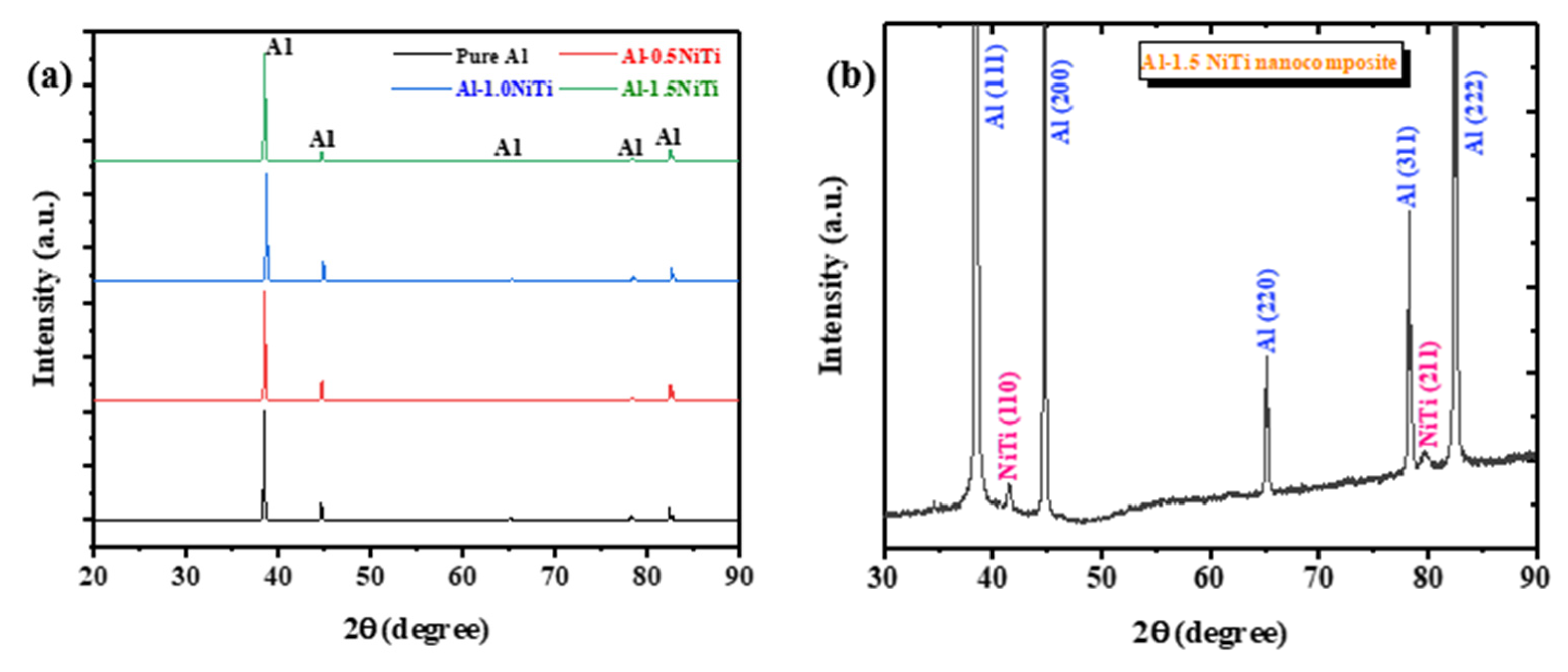
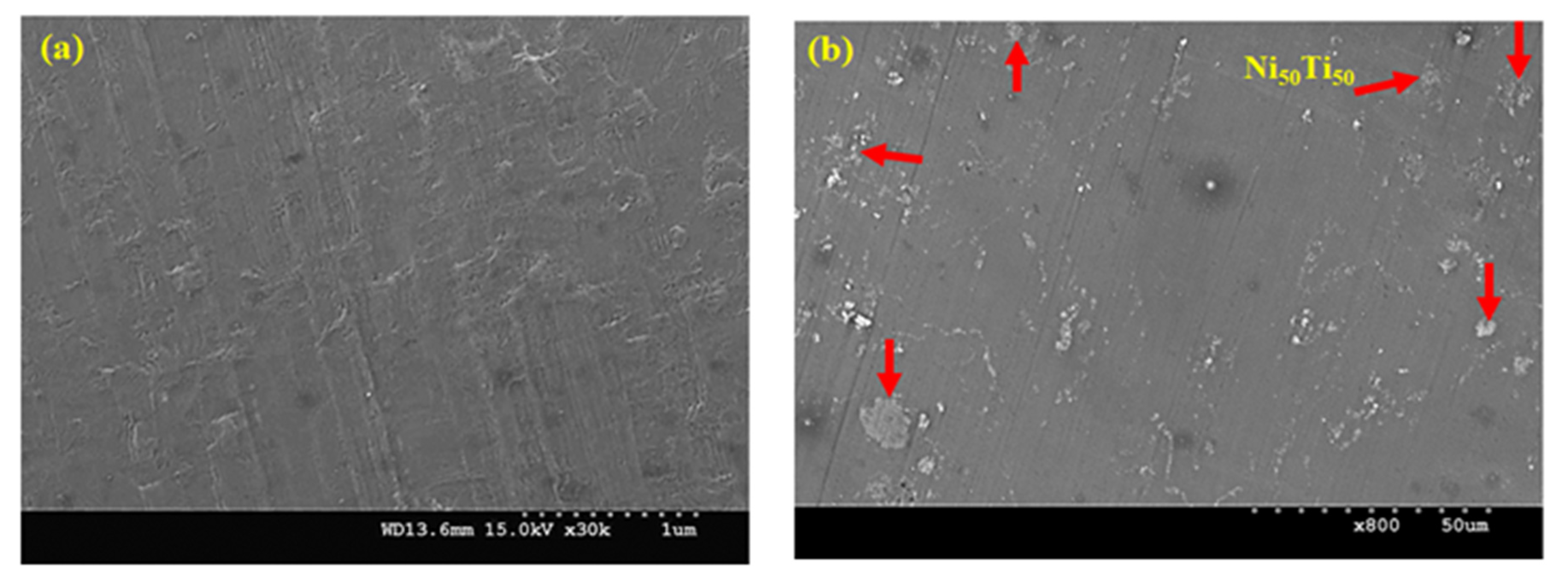
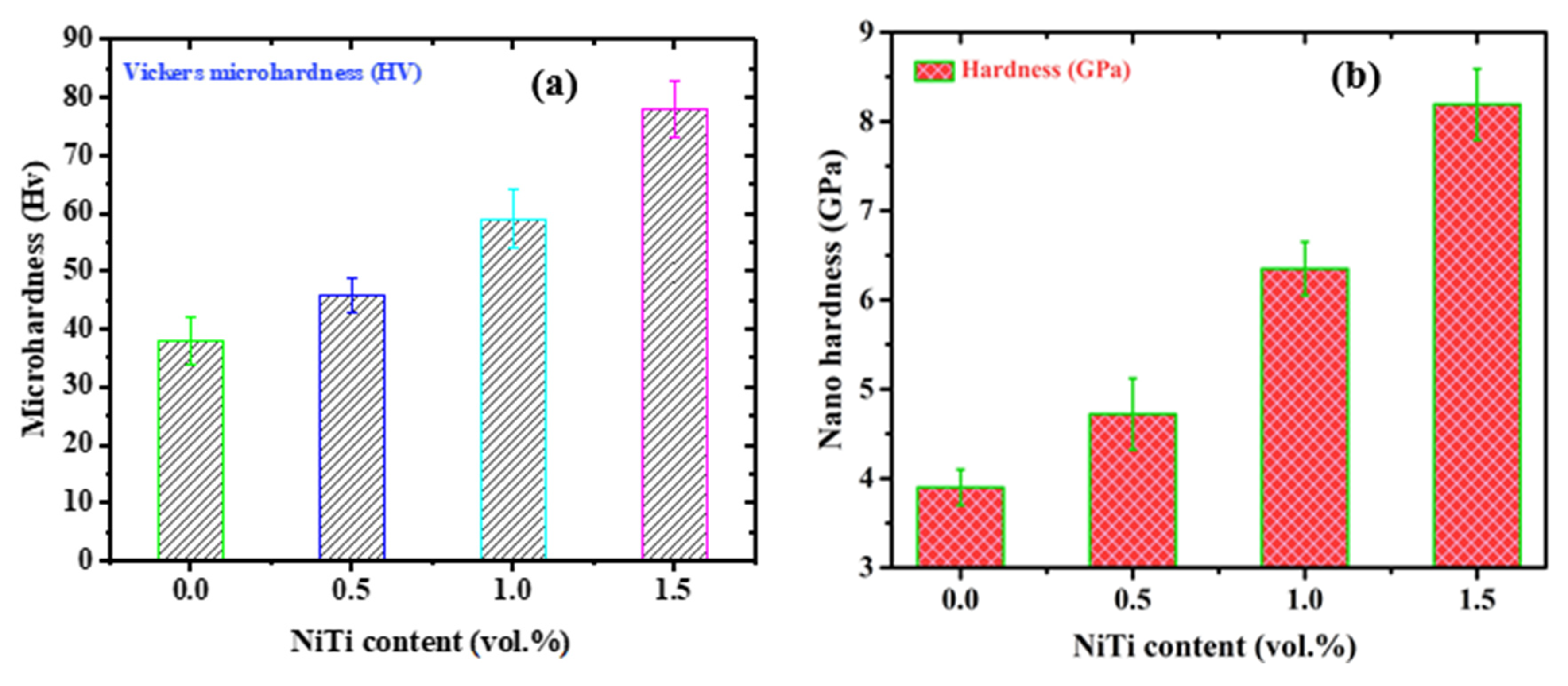
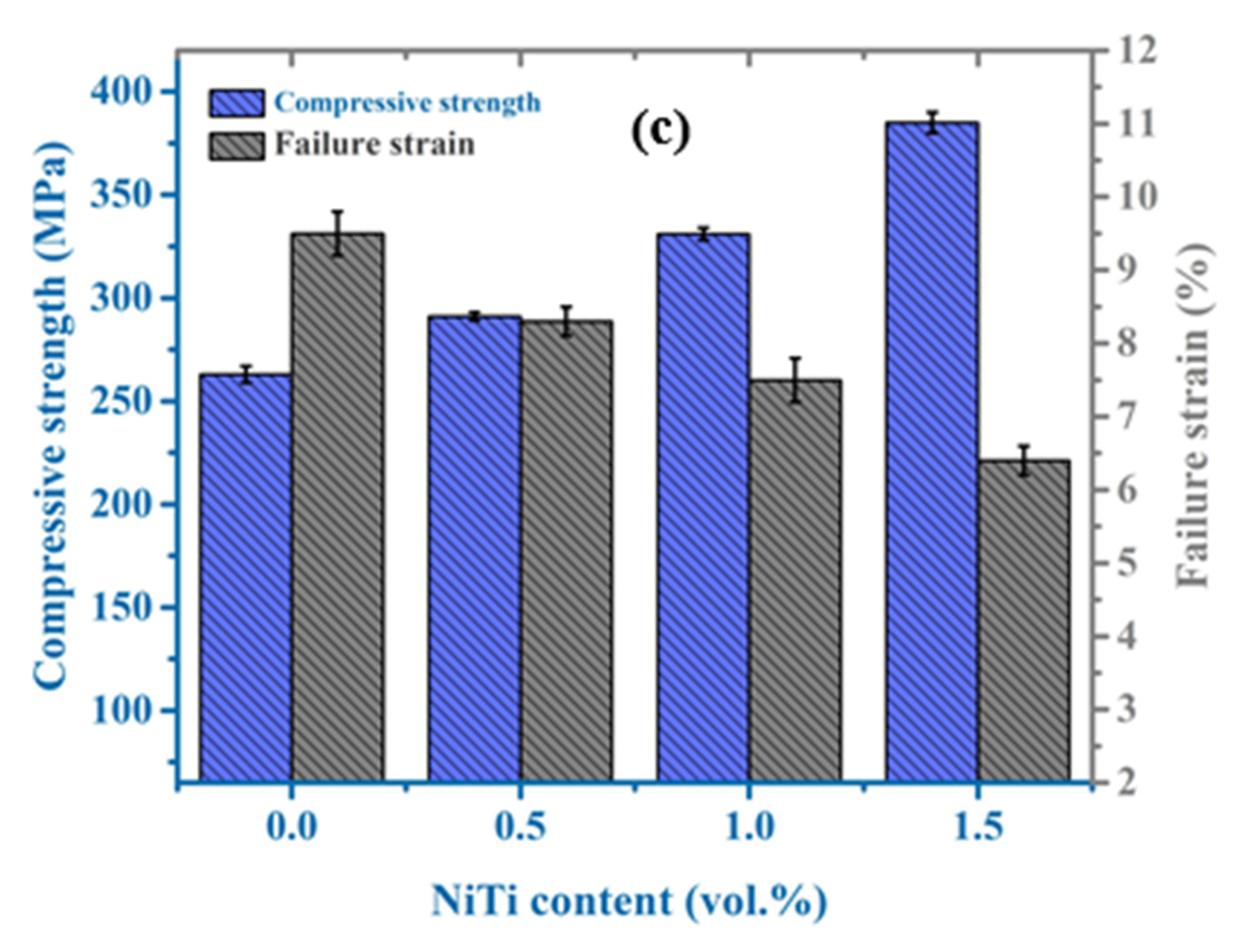
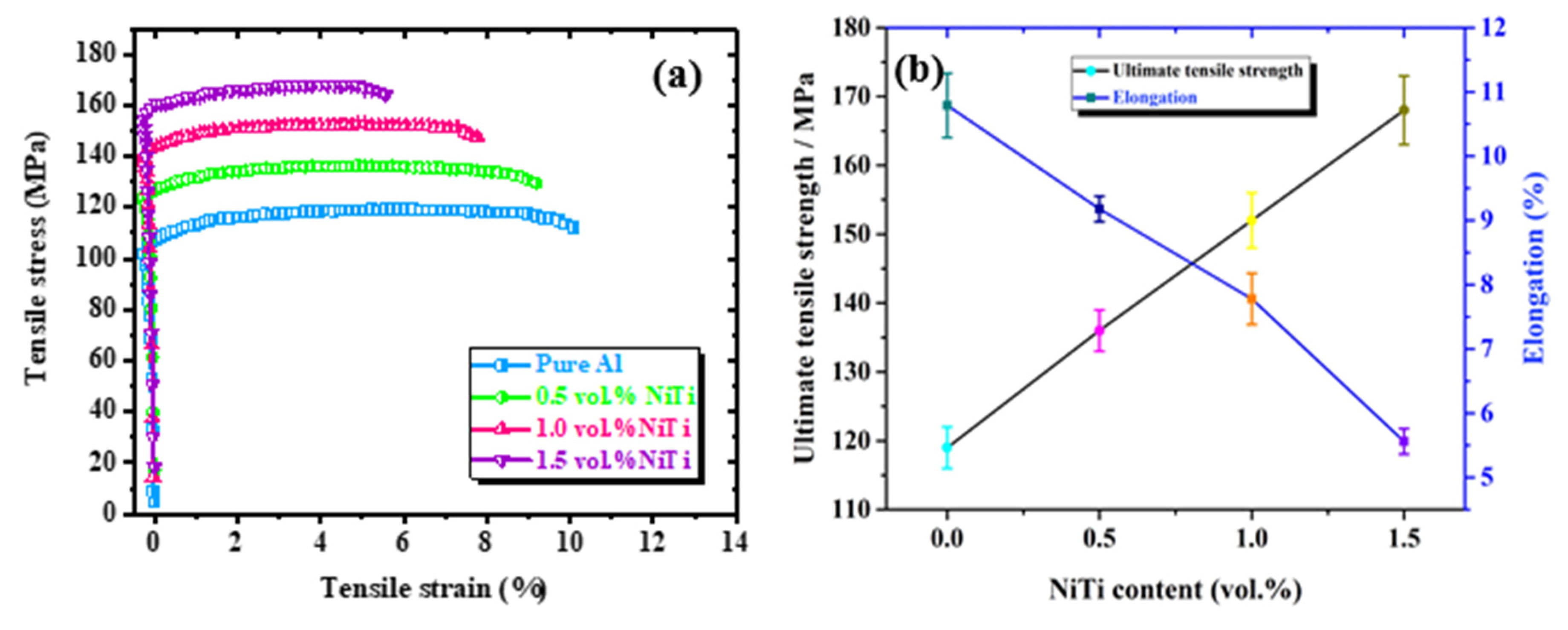
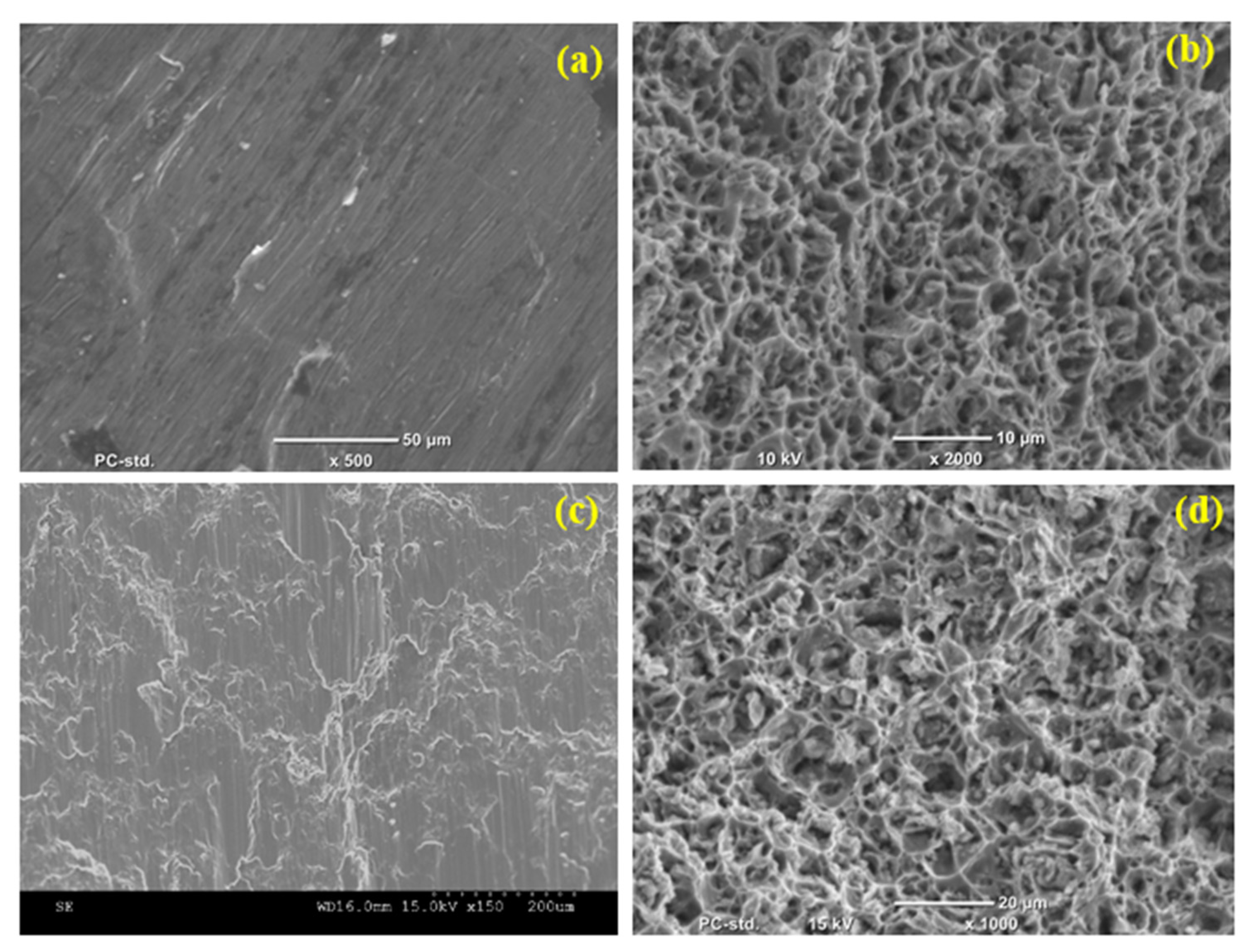
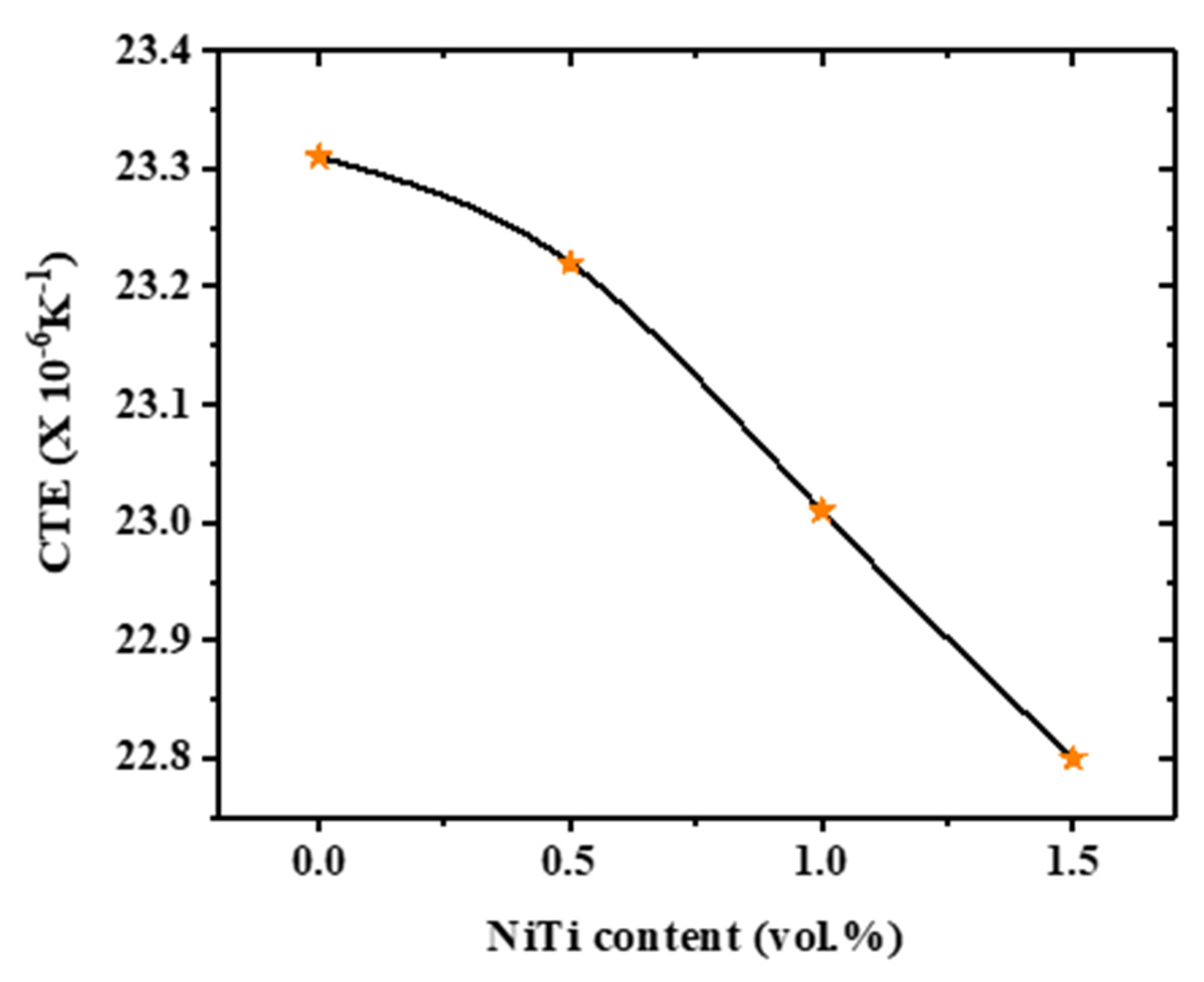

| Hardness | Compressive Properties | Tensile Properties | ||||||
|---|---|---|---|---|---|---|---|---|
| Sample | (Hv) Micro | (GPa) Nano | CYS (MPa) | UCS (MPa) | Failure Strain (%) | TYS (MPa) | UTS (MPa) | Elongation (%) |
| Pure Al | 38 ± 4 | 3.9 ± 0.2 | 70 ± 3 | 263 ± 4 | 9.5 ± 0.2 | 106 ± 3 | 119 ± 3 | 10.8 ± 0.5 |
| Al-0.5 vol % NiTi | 46 ± 3 (↑21%) | 4.7 ± 0.4 (↑20%) | 76 ± 2 (↑8%) | 291 ± 2 (↑10%) | 8.3 ± 0.4 (↓12%) | 124 ± 5 (↑17%) | 136 ± 3 (↑14%) | 9.2 ± 0.2 (↓15%) |
| Al-1.0 vol % NiTi | 59 ± 5 (↑55%) | 6.3 ± 0.3 (↑61%) | 88 ± 3 (↑25%) | 331 ± 3 (↑26%) | 7.5 ± 0.3 (↓21%) | 141 ± 2 (↑33%) | 152 ± 4 (↑28%) | 7.8 ± 0.4 (↓28%) |
| Al-1.5 vol % NiTi | 78 ± 5 (↑105%) | 8.2 ± 0.4 (↑110%) | 97 ± 4 (↑38%) | 385 ± 5 (↑46%) | 6.4 ± 0.4 (↓32%) | 154 ± 3 (↑45%) | 168 ± 5 (↑41%) | 5.5 ± 0.2 (↓49%) |
| Al-5 vol % Ni60Nb60 [2] | 74.5 ± 4 | -- | 114 ± 6 | 300 ± 5 | >50 | 50 ± 9 | 60 ± 3 | 16.8 ± 2 |
| Al-1.5 vol % BN [10] | 88 ± 4 | 9.5 ± 0.5 | 64 ± 6 | 391 ± 5 | 6.3 ± 0.3 | 144 ± 2 | 158 ± 4 | 6.9 ± 0.4 |
| Al-1.5 vol % SiC [11] | 82 ± 4 | -- | 114 ± 7 | 392 ± 6 | >75 | 158 ± 9 | 178 ± 6 | 7.3 ± 0.9 |
| Al-4 vol % Ni49.8Nb50.2 [27] | -- | -- | -- | -- | -- | 32 | 38 | >4 |
| Al-3 wt % SiO2 [38] | 38.7 | -- | 142 | 268 | 2.8 | 100 | 137 | 0.9 |
| Al-4 vol % (Ti,W)C [39] | 52 ± 4 | -- | 118 ± 1 | 346 ± 6 | 39 ± 2 | -- | -- | -- |
| Composition | Damping Capacity (× 10−4) | Damping Loss Rate | Elastic Modulus (GPa) |
|---|---|---|---|
| Pure Al | 5.33 ± 0.056 | 14.76 ± 0.09 | 71.65 ± 0.02 |
| Al-0.5 vol % NiTi | 4.17 ± 0.031 (↓21.7%) | 11.65 ± 0.06 (↓21%) | 75.99 ± 0.02 (↑6.05%) |
| Al-1.0 vol % NiTi | 5.65 ± 0.029 (↑6%) | 15.2 ± 0.06 (↑2.98%) | 76.48 ± 0.01 (↑6.74%) |
| Al-1.5 vol % NiTi | 6.15 ± 0.029 (↑15.4%) | 17.15 ± 0.06 (↑16.19%) | 75.93 ± 0.08 (↑5.97%) |
© 2020 by the authors. Licensee MDPI, Basel, Switzerland. This article is an open access article distributed under the terms and conditions of the Creative Commons Attribution (CC BY) license (http://creativecommons.org/licenses/by/4.0/).
Share and Cite
Matli, P.R.; Manakari, V.; Parande, G.; Mattli, M.R.; Shakoor, R.A.; Gupta, M. Improving Mechanical, Thermal and Damping Properties of NiTi (Nitinol) Reinforced Aluminum Nanocomposites. J. Compos. Sci. 2020, 4, 19. https://doi.org/10.3390/jcs4010019
Matli PR, Manakari V, Parande G, Mattli MR, Shakoor RA, Gupta M. Improving Mechanical, Thermal and Damping Properties of NiTi (Nitinol) Reinforced Aluminum Nanocomposites. Journal of Composites Science. 2020; 4(1):19. https://doi.org/10.3390/jcs4010019
Chicago/Turabian StyleMatli, Penchal Reddy, Vyasaraj Manakari, Gururaj Parande, Manohar Reddy Mattli, Rana Abdul Shakoor, and Manoj Gupta. 2020. "Improving Mechanical, Thermal and Damping Properties of NiTi (Nitinol) Reinforced Aluminum Nanocomposites" Journal of Composites Science 4, no. 1: 19. https://doi.org/10.3390/jcs4010019
APA StyleMatli, P. R., Manakari, V., Parande, G., Mattli, M. R., Shakoor, R. A., & Gupta, M. (2020). Improving Mechanical, Thermal and Damping Properties of NiTi (Nitinol) Reinforced Aluminum Nanocomposites. Journal of Composites Science, 4(1), 19. https://doi.org/10.3390/jcs4010019










